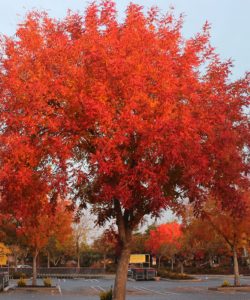Fall is the best tree-planting season in the Sacramento region
By Debbie Arrington
Guest Writer
Shade. On a scorching summer day, it’s one of the most valuable assets for any home in the Sacramento region – AND you can grow your own.
“It’s the difference between a livable summer and one that’s really stifling, not just uncomfortable but could threaten your life,” says Stephanie Robinson, communications and marketing manager for the Sacramento Tree Foundation. “If you lost a big shade tree recently, you really noticed the difference – especially this summer. You don’t realize until it’s gone how valuable shade is.”
Not only is your own home impacted, she adds. “Shade trees keep your whole neighborhood cooler. Without trees, all that heat is absorbed by asphalt.”
 Tree-lined streets lower the temperature of surrounding homes and improve the neighborhood’s quality of life, Robinson notes. “That’s why it’s one of the main priorities for our mission (at the foundation); plant more shade.”
Tree-lined streets lower the temperature of surrounding homes and improve the neighborhood’s quality of life, Robinson notes. “That’s why it’s one of the main priorities for our mission (at the foundation); plant more shade.”
Sacramento Tree Foundation volunteers tested their theories of shade tree impact on neighborhoods with a drive around Sacramento neighborhoods on a summer afternoon, Robinson says. “There was a 20-degree difference between the hottest and the shadiest neighborhoods at afternoon peak highs. That can be the difference between life and death for people without air conditioning.”
Now is the time to plan ahead and plant some shade. Fall is the best tree-planting season in the greater Sacramento area. While some trees have reputations as water hogs (specifically coastal redwoods), many other water-wise choices are available.
“If you’re re-doing your landscape, think trees first,” says Robinson. “It’s not just shade, but wildlife habitat. You can build trees into your water budget. It costs less than $3 a month to water a mature tree. A young tree costs only pennies. You can afford to invest in that shade.”
The Sacramento Tree Foundation partners with the Sacramento Municipal Utility District (SMUD) to offer up to 10 free shade trees to customers. Since 1990, the program has planted more than 600,000 local trees. You can find details here: https://www.smud.org/en/Going-Green/Free-Shade-Trees
Participants contact the Sacramento Tree Foundation and set up an appointment with a community forester. The program has expanded to include evergreens as well as trees that shade other portions of a customer’s property besides their home.
“Shading landscape saves water because there’s less transpiration,” Robinson says. “There are many benefits of shade trees.”
Among the most popular water-wise shade trees for Sacramento landscapes are native oaks, varieties include Valley, interior live and blue (see Water-Wise Favorites below for more information).
“People love oaks,” says Robinson. “They’re sturdy, long lived and (the deciduous varieties) offer a rainbow of fall color.”
Oaks take time to grow. A faster option is a zelkova; native to Japan, these trees can reach 60 feet in a hurry. “It’s a big, beautiful shade tree that grows fast,” Robinson says.
“Chinese pistache are still very popular, and the new cultivars are not as messy,” she adds. “Right now, people are very interested in trees that flower and support pollinators. The favorites are desert willow, vitex and strawberry trees.”
The Sacramento Tree Foundation has many more suggestions in its “Shady 80,” its selection of best trees for Sacramento: https://sactree.org/best-trees-for-sacramento/.
Water-Wise Favorites
Sacramento Tree Foundation community forester, Marisol Villarreal, recommends these water-wise trees:
- Valley oak: A large and adaptable deciduous native oak that is the cornerstone species of our ecosystem; many types of pollinators, butterflies, birds and other wildlife depend on these trees for habitat.
- Interior live oak: A large evergreen native oak with a wide-spreading canopy; also supports native wildlife.
- Blue oak: A large deciduous oak with blue-green leaves that is native to dry slopes and foothills; very sensitive to overwatering.
- Vitex: A small deciduous tree or shrub with delicate spikes of blue flowers that are bee favorites.
- Persian ironwood: A medium-sized tree with strong wood, red new growth, striking fall color and interesting red flowers.
- Strawberry tree: A medium-sized evergreen with twisting branches showing off peeling, red bark; tiny pink bell-shaped flowers support pollinators and attract hummingbirds before turning into fruit that resembles red pom-poms – or strawberries.
Debbie Arrington is a longtime home and garden reporter and co-author of the blog Sacramento Digs Gardening: https://sacdigsgardening.californialocal.com/

